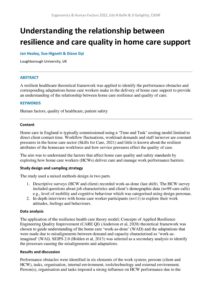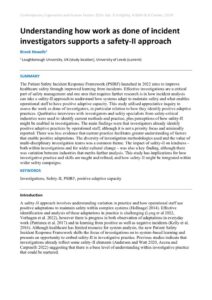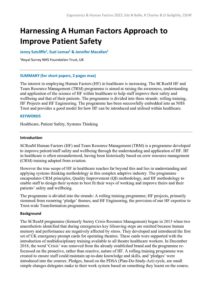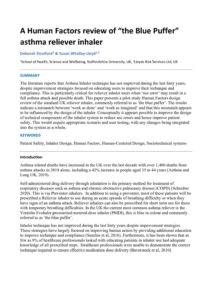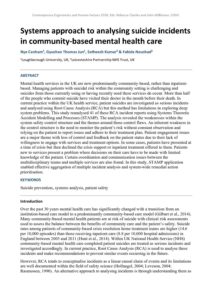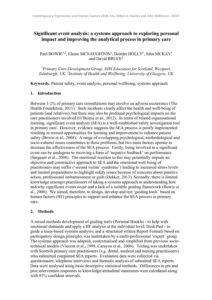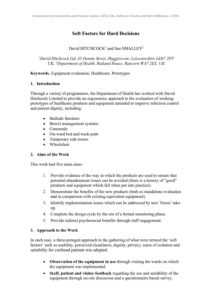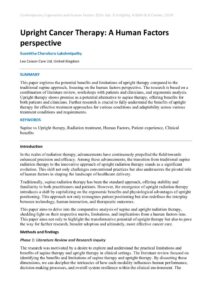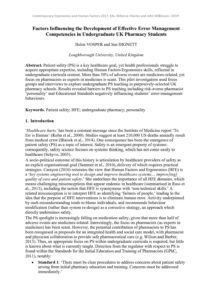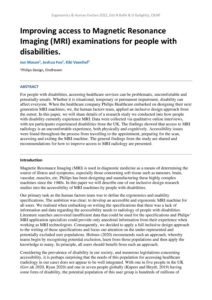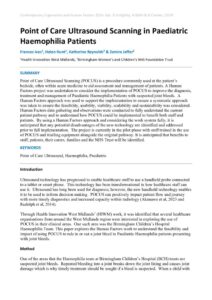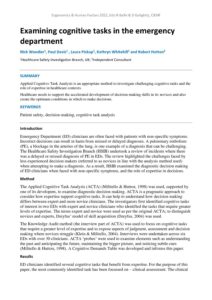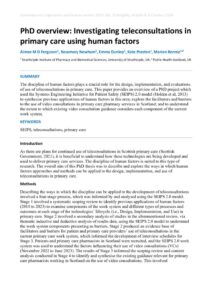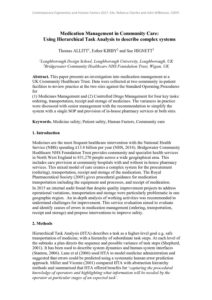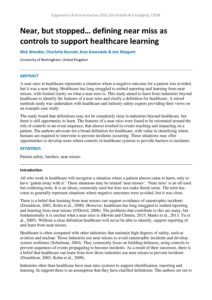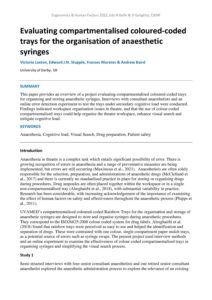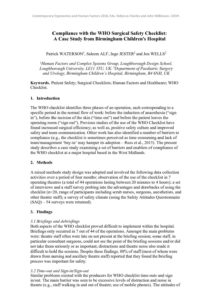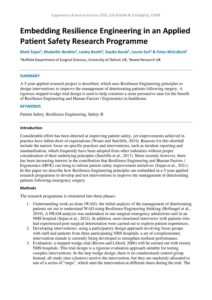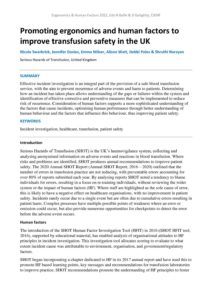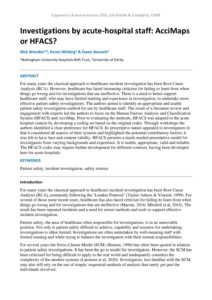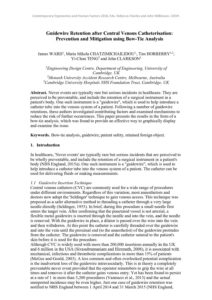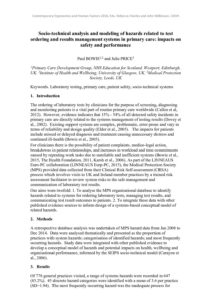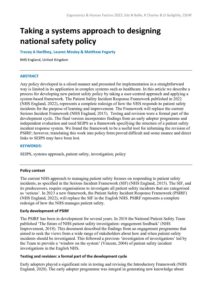Patient Safety
Understanding the relationship between resilience and care quality in home care support
| Document | Author Jan Healey, Sue Hignett & Diane Gyi |
| Abstract A resilient healthcare theoretical framework was applied to identify the performance obstacles and corresponding adaptations home care workers make in the delivery of home care support to provide an understanding of the relationship between home care resilience and quality of care. |
Understanding how work as done of incident investigators supports a safety-II approach
| Document | Author Brook Howells |
| Abstract The Patient Safety Incident Response Framework (PSIRF) launched in 2022 aims to improve healthcare safety through improved learning from incidents. Effective investigations are a critical part of safety management and one area that requires further research is in how incident analysis can take a safety-II approach to understand how systems adapt to maintain safety and what enables operational staff to have positive adaptive capacity. This study utilised appreciative inquiry to assess the work as done of investigators, in particular relation to how they identify positive adaptive practices. Qualitative interviews with investigators and safety specialists from safety-critical industries were used to identify current methods and practice, plus perceptions of how safety-II might be enabled in investigations. The main findings were that investigators already identify positive adaptive practices by operational staff, although it is not a priority focus and minimally reported. There was less evidence that current practice facilitates greater understanding of factors that enable positive adaptations. The diversity of investigation methodologies used and the value of multi-disciplinary investigation teams was a common theme. The impact of safety-II on kindness – both within investigations and for wider cultural change – was also a key finding, although there was variation between industries that merits further analysis. This study has implications for how investigative practice and skills are taught and refined, and how safety-II might be integrated within wider safety campaigns. |
Harnessing A Human Factors Approach to Improve Patient Safety
| Document | Author Jenny Sutcliffe, Suzi Lomax & Jennifer Macallan |
| Abstract The interest in employing Human Factors (HF) in healthcare is increasing. The SCReaM HF and Team Resource Management (TRM) programme is aimed at raising the awareness, understanding and application of the science of HF within healthcare to help staff improve their safety and wellbeing and that of their patients. The programme is divided into three strands: rolling training, HF Projects and HF Engineering. The programme has been successfully embedded into an NHS Trust and provides a good model for how HF can be introduced and utilised within healthcare. |
A Human Factors review of “the Blue Puffer” asthma reliever inhaler
| Document | Author Deborah Stratford & Susan Whalley-Lloyd |
| Abstract The literature reports that Asthma Inhaler technique has not improved during the last forty years, despite improvement strategies focused on educating users to improve their technique and compliance. This is particularly critical for reliever inhaler users when ‘use error’ may result in a full asthma attack and possible death. This paper presents a pilot study Human Factors design review of the standard UK reliever inhaler, commonly referred to as ‘the blue puffer’. The results indicate a mismatch between ‘work as done’ and ‘work as imagined’ and that this mismatch appears to be influenced by the design of the inhaler. Conceptually it appears possible to improve the design of technical components of the inhaler system to reduce use errors and hence improve patient safety. This would require appropriate scenario and user testing, with any changes being integrated into the system as a whole. |
Systems approach to analysing suicide incidents in community-based mental health care
| Document | Author Nye Canham, Gyuchan Thomas Jun, Satheesh Kumar & Fabida Noushad |
| Abstract Mental health services in the UK are now predominantly community-based, rather than inpatient-based. Managing patients with suicidal risk within the community setting is challenging and suicides from those currently using or having recently used these services do occur. More than half of the people who commit suicide have visited their doctor in the month before their death. In current practice within the UK health service, patient suicides are investigated as serious incidents and analysed using Root Cause Analysis (RCA) but this method has limitations in exploring deep system problems. This study reanalysed 41 of these RCA incident reports using Systems Theoretic Accident Modelling and Processes (STAMP). The analysis revealed the weaknesses within the system safety control structure and the themes around those control flaws. An inherent weakness in the control structure is the need to monitor the patient’s risk without constant observation and relying on the patient to report issues and adhere to their treatment plan. Patient engagement issues are a major theme with loss of control and feedback on the patient status due to their lack of willingness to engage with services and treatment options. In some cases, patients have presented at a time of crisis but then declined the crisis support or inpatient treatment offered to them. Patients new to services present a problem where decisions on their care have to be made with limited knowledge of the patient. Certain coordination and communication issues between the multidisciplinary teams and multiple services are also found. In this study, STAMP application enabled effective aggregation of multiple incident analysis and system-wide remedial action prioritisation. |
Significant event analysis: a systems approach to exploring personal impact and improving the analytical process in primary care
| Document | Author Paul BOWIE, Elaine MCNAUGHTON, Deirdre HOLLY, John MCKAY and David BRUCE |
| Abstract |
Soft Factors for Hard Decisions
| Document | Author David HITCHCOCK and Sue SMALLEY |
| Abstract |
Upright Cancer Therapy: A Human Factors perspective
| Document | Author Susmitha Cherukuru Lakshmipathy |
| Abstract This paper explores the potential benefits and limitations of upright therapy compared to the traditional supine approach, focusing on the human factors perspective. The research is based on a combination of literature review, workshops with patients and clinicians, and ergonomic analysis. Upright therapy shows promise as a potential alternative to supine therapy, offering benefits for both patients and clinicians. Further research is crucial to fully understand the benefits of upright therapy for effective treatment approaches for various conditions and adaptability across various treatment conditions and requirements. |
Factors Influencing the Development of Effective Error Management Competencies in Undergraduate UK Pharmacy Students
| Document | Author Helen VOSPER and Sue HIGNETT |
| Abstract Patient safety (PS) is a key healthcare goal, yet health professionals struggle to acquire appropriate expertise, including Human Factors/Ergonomics skills, reflected in undergraduate curricula content. More than 50% of adverse events are medicines-related, yet focus on pharmacists as experts in medicines is scant. This pilot investigation used focus groups and interviews to explore undergraduate PS teaching in purposively-selected UK pharmacy schools. Results revealed barriers to PS teaching including risk-averse pharmacist ‘personality’ and Educational Standards negatively influencing students’ error-management behaviours. |
Improving access to Magnetic Resonance Imaging (MRI) examinations for people with disabilities
| Document | Author Jon Mason, Joshua Fox & Kiki Veenhof |
| Abstract For people with disabilities, accessing healthcare services can be problematic, uncomfortable and potentially unsafe. Whether it is situational, temporary or permanent impairment, disability can affect everyone. When the healthcare company Philips Healthcare embarked on designing their next generation MRI machines, we, the human factors team, applied an inclusive design approach from the outset. In this paper, we will share details of a research study we conducted into how people with disability currently experience MRI. Data were collected via qualitative online interviews, with ten participants experienced disabilities from the UK. The findings showed that access to MRI radiology is an uncomfortable experience, both physically and cognitively. Accessibility issues were found throughout the process from travelling to the appointment, preparing for the scan, accessing and exiting the MRI machine. The general findings from the study are shared and recommendations for how to improve access to MRI radiology are presented. |
Point of Care Ultrasound Scanning in Paediatric Haemophilia Patients
| Document | Author Frances Ives, Helen Hunt, Katherine Reynolds & Zamira Jaffer |
| Abstract Point of Care Ultrasound Scanning (POCUS) is a procedure commonly used at the patient’s bedside, often within acute medicine to aid assessment and management of patients. A Human Factors project was undertaken to consider the implementation of POCUS to improve the diagnosis, treatment and management of Paediatric Haemophilia Patients with suspected joint bleeds. A Human Factors approach was used to support the implementation to ensure a systematic approach was taken to ensure the feasibility, usability, viability, scalability and sustainability was considered. Human Factors data gathering and observations were conducted to fully understand the current patient pathway and to understand how POCUS could be implemented to benefit both staff and patients. By using a Human Factors approach and considering the work system fully, it is anticipated that any potential disadvantages of the new technology are identified and addressed prior to full implementation. The project is currently in the pilot phase with staff trained in the use of POCUS and trialling equipment alongside the original pathway. It is anticipated that benefits to staff, patients, their carers, families and the NHS Trust will be identified. |
Examining cognitive tasks in the emergency department
| Document | Author Nick Woodier, Paul Davis, Laura Pickup, Kathryn Whitehill & Robert Hutton |
| Abstract Applied Cognitive Task Analysis is an appropriate method to investigate challenging cognitive tasks and the role of expertise in healthcare contexts. Healthcare needs to support the accelerated development of decision-making skills in its novices and also create the optimum conditions in which to make decisions. |
PhD overview: Investigating teleconsultations in primary care using human factors
| Document | Author Aimee M D Ferguson, Rosemary Newham, Emma Dunlop, Kate Preston, Marion Bennie |
| Abstract The discipline of human factors plays a crucial role for the design, implementation, and evaluations of use of teleconsultations in primary care. This paper provides an overview of a PhD project which used the Systems Engineering Initiative for Patient Safety (SEIPS) 2.0 model (Holden et al, 2013) to synthesise previous applications of human factors in this area; explore the facilitators and barriers to the use of video consultations in primary care pharmacy services in Scotland; and to understand the extent to which existing video consultation guidance considers each component of the current work system. |
Medication Management in Community Care: Using Hierarchical Task Analysis to describe complex systems
| Document | Author Thomas ALLITT, Esther KIRBY and Sue HIGNETT |
| Abstract This paper presents an investigation into medication management at a UK Community Healthcare Trust. Data were collected at two community in-patient facilities to review practice at the two sites against the Standard Operating Procedures for (1) Medicines Management and (2) Controlled Drugs Management for four key tasks: ordering, transportation, receipt and storage of medicines. The variances in practice were discussed with senior management with the recommendation to simplify the system with a single SOP and provision of in-house pharmacy services at both sites. |
Near, but stopped… defining near miss as controls to support healthcare learning
| Document | Author Nick Woodier, Charlotte Burnett, Bryn Baxendale & Iain Moppett |
| Abstract A near miss in healthcare represents a situation where a negative outcome for a patient was avoided, but it was a near thing. Healthcare has long struggled to embed reporting and learning from near misses, with limited clarity on what a near miss is. This study aimed to learn from industries beyond healthcare to identify the features of a near miss and clarify a definition for healthcare. A mixed methods study was undertaken with healthcare and industry safety experts providing their views on an example case study. The study found that definitions may not be completely clear in industries beyond healthcare, but there is still opportunity to learn. The features of a near miss were found to be orientated around the role of controls in an event sequence, that almost resulted in events reaching and impacting on a patient. The authors advocate for a broad definition for healthcare, with value in identifying where humans are required to intervene to prevent incidents occurring. These situations may offer opportunities to develop more robust controls in healthcare systems to provide barriers to incidents. |
Evaluating compartmentalised coloured-coded trays for the organisation of anaesthetic syringes
| Document | Author Victoria Laxton, Edward J.N. Stupple, Frances Maratos & Andrew Baird |
| Abstract This paper provides an overview of a project evaluating compartmentalised coloured-coded trays for organising and storing anaesthetic syringes. Interviews with consultant anaesthetists and an online error detection experiment to test the trays under secondary cognitive load were conducted. Findings indicated workspace organisation issues in theatre, and that the use of colour-coded compartmentalised trays could help organise the theatre workspace, enhance visual search and mitigate cognitive load. |
Compliance with the WHO Surgical Safety Checklist: A Case Study from Birmingham Children’s Hospital
| Document | Author Patrick WATERSON, Saleem ALI, Ingo JESTER and Jon WELLS |
| Abstract |
Embedding Resilience Engineering in an Applied Patient Safety Research Programme
| Document | Author Mark Sujan, Mudathir Ibrahim, Lesley Booth, Saydia Razak, Laurie Earl & Peter McCulloch |
| Abstract A 5-year applied research project is described, which uses Resilience Engineering principles to design interventions to improve the management of deteriorating patients following surgery. A rigorous stepped-wedge trial design is used to help construct a more persuasive case for the benefit of Resilience Engineering and Human Factors / Ergonomics in healthcare. |
Promoting ergonomics and human factors to improve transfusion safety in the UK
| Document | Author Nicola Swarbrick, Jennifer Davies, Emma Milser, Alison Watt, Debbi Poles & Shruthi Narayan |
| Abstract Effective incident investigation is an integral part of the provision of a safe blood transfusion service, with the aim to prevent recurrence of adverse events and harm to patients. Determining how an incident has taken place allows understanding of the gaps or failures within the system and identification of effective corrective and preventive measures that can be implemented to reduce risk of recurrence. Consideration of human factors supports a more sophisticated understanding of the factors that cause incidents, optimising human performance through better understanding of human behaviour and the factors that influence this behaviour, thus improving patient safety. |
Investigations by acute-hospital staff: AcciMaps or HFACS?
| Document | Author Nick Woodier, Karen Whiting & Owen Bennett |
| Abstract For many years the classical approach to healthcare incident investigation has been Root Cause Analysis (RCA). However, healthcare has faced increasing criticism for failing to learn from when things go wrong and for investigations that are ineffective. There is a need to better support healthcare staff, who may have limited training and experience in investigation, to undertake more effective patient safety investigations. The authors aimed to identify an appropriate and usable patient safety investigation method for use by healthcare staff. The result of a literature review and engagement with experts led the authors to focus on the Human Factors Analysis and Classification System (HFACS) and AcciMap. Prior to evaluating the methods, HFACS was adapted to the acute hospital context by developing a coding set based on the original codes. Through workshops the authors identified a clear preference for HFACS. Its prescriptive nature appealed to investigators in that it considered all aspects of their systems and highlighted the potential contributory factors; it was felt to have face and content validity. HFACS presents a much-needed prescriptive model for investigators from varying backgrounds and experience. It is usable, appropriate, valid and reliable. The HFACS codes may require further development for different contexts, having been developed here for acute hospitals. |
Guidewire Retention after Central Venous Catheterisation: Prevention and Mitigation using Bow-Tie Analysis
| Document | Author James WARD, Maria Mikela CHATZIMICHAILIDOU, Tim HORBERRY, Yi-Chun TENG and John CLARKSON |
| Abstract Never events are typically rare but serious incidents in healthcare. They are perceived to be preventable, and include the retention of a surgical instrument in a patient's body. One such instrument is a "guidewire", which is used to help introduce a catheter tube into the venous system of a patient. Following a number of guidewire retentions, these authors investigated contributing factors and examined mechanisms to reduce the risk of further occurrences. This paper presents the results in the form of a bow-tie analysis, which was found to provide an effective way to graphically display and examine the issue. |
Socio-technical analysis and modeling of hazards related to test ordering and results management systems in primary care: impacts on safety and performance
| Document | Author Paul BOWIE and Julie PRICE |
| Abstract |
Taking a systems approach to designing national safety policy
| Document | Author Tracey A Herlihey, Lauren Mosley & Matthew Fogarty |
| Abstract Any policy developed in a siloed manner and presented for implementation in a straightforward way is limited in its application in complex systems such as healthcare. In this article we describe a process for developing new patient safety policy by taking a user-centred approach and applying a system-based framework. The Patient Safety Incident Response Framework published in 2022 (NHS England, 2022), represents a complete redesign of how the NHS responds to patient safety incidents for the purpose of learning and improvement. The Framework will replace the current Serious Incident Framework (NHS England, 2015). Testing and revision were a formal part of the development cycle. The final version incorporates findings from an early adopter programme and independent evaluation and used SEIPS as a framework specifying the structure of a patient safety incident response system. We found the framework to be a useful tool for informing the revision of PSIRF; however, translating this work into policy form proved difficult and some nuance and direct links to SEIPS may have been lost. |

